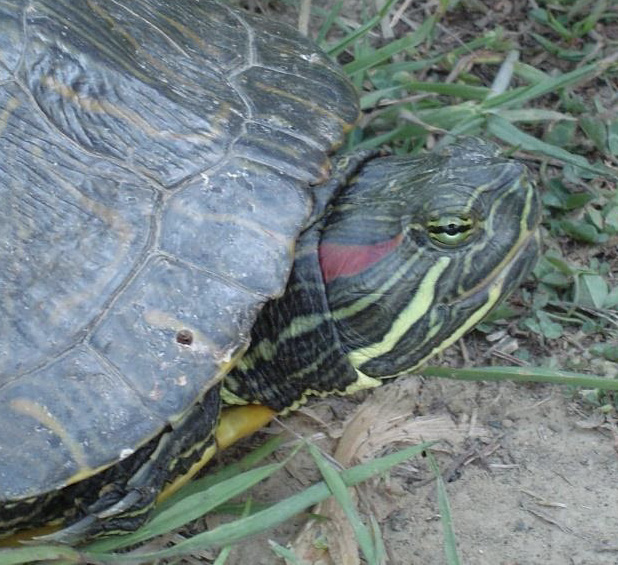Featured Scientist: Dr. Amanda Wilson Carter (she/her/hers)

Birthplace: New York City, NY
My Research: I study how animals are affected by changes in their environments.
Research Goals: I want to understand how changes in temperature affect animal physiology. I would like to be able to better predict how climate change will affect all types of animals.
Career Goals: I am currently working towards increasing the participation of underrepresented groups in science. My goal is to become a biology professor and researcher.
Hobbies: Traveling, playing with my dogs, and renovating my 1940’s bungalow.
Favorite Thing About Science: I love having the freedom to explore questions that I think are necessary and important. Throughout my schooling and career, I have also discovered a passion for mentoring students through independent projects in the lab. There is something very special about watching an undergraduate conduct their first study and transform into a confident and capable young investigator.
Organism of Study: I study many animals, but my PhD research focused on turtles, mainly the red-eared slider (Trachemys scripta). In my current position, I conduct research on dung beetles.

Field of Study: Eco-physiology | Climate Change | Plasticity | Development | Parental Effects
What is Eco-physiology? I broadly consider myself an eco-physiologist. I study how the physiology and behavior of animals are affected by their environment (mainly temperature).
Check Out My Original Paper: “Evidence of embryonic regulation of maternally derived yolk corticosterone”

Citation: A. W. Carter, R.M. Bowden, R.T. Paitz, Evidence of embryonic regulation of maternally derived yolk corticosterone. J. Exp. Biol. 221.22 (2018).
Synopsis written by: Ashley Waring, PhD (Anticipated Fall 2023), School of Biological Sciences, Illinois State University
Research at a Glance: When a mother is stressed, it can affect her future offspring. It can negatively affect them while they are developing and can also affect their survival after they are born. The goal of this study was to understand how maternal stress affects offspring by investigating how corticosterone, a hormone related to stress, affects embryos. In order to test this, turtle eggs from the species Trachemys scripta (red-eared slider turtle) were exposed to high levels of corticosterone. Amanda found out that the embryo will process most of the corticosterone. By the end of her study, less than 1% of the corticosterone was left in the embryo. This shows that, even when a lot of the stress hormone is present, it doesn’t necessarily have a large effect on the embryo. However, if the amount of corticosterone was more than the embryo could handle, some of the embryos did not survive. When embryos did survive and hatch, the hatchling turtles tended to be smaller and have more physical malformations than those that were not exposed to corticosterone. Embryos that had been exposed to corticosterone also took longer to hatch. Amanda’s results show that maternal stress causes a variety of effects on offspring and that too much maternal stress via increased corticosterone can have strong negative impacts. Some of these negative effects exist in traits that are important for survival and reproduction, so maternal stress can harm the offspring’s chances at reproducing successfully. However, since the embryos were able to process some levels of corticosterone, it’s possible that offspring can survive lower levels of maternal stress.
Highlights: Figure 1 shows that, at high levels, corticosterone decreases how many turtle embryos will survive. The bar on the far left, labeled “Control”, shows the mortality rate when no corticosterone is given to the embryo. Each bar to the right shows how many turtles died as the corticosterone dose increased.

At low levels of corticosterone (0.05 μg and 0.15 μg) there is almost no change in survival. However, at a high level (0.5 μg), there is a large jump in embryo mortality. This suggests that there might be a threshold point, where the embryo can no longer cope with the amount of corticosterone.
What My Science Looks Like: Below is a picture of Amanda collecting turtle eggs in the field. She looks for female turtles nesting in the dirt, then digs up the eggs that they lay.

The Big Picture: This research provided the scientific community with a better understanding of maternal-offspring relationships. It helped explain the dynamics of stress and how maternal stress may affect the offspring. There are many ways that humans can cause stress in animal mothers, and the potential effects of that are still unknown. However, we now know that there may be a point where the level of stress causes harm. So, moving forward as a society, we need to be aware of how we treat our environment and what stressful effects that will have on animals.
Decoding the Language:
Corticosterone: The hormone produced in response to stress.
Embryo: An unborn or unhatched offspring that is actively growing. In the context of Amanda’s research, the embryo is the developing turtle inside the egg.
Malformations: Malformation refers to a part of a body that has not formed normally.
Maternal Stress: Maternal stress refers to the stress that a mother experiences during pregnancy.
Physiology: A branch of biology that studies how different parts of the body carry out chemical and physical functions.
Trachemys scripta (T. scripta): The scientific name for the red-eared slider turtle.
Learn More:
Bowden Lab website (former Doctoral Program)
The role of corticosterone in the body
Synopsis edited by: Brie Oceguera Walk, M.S. 2020 and Eric Walsh, M.S. 2020, School of Biological Sciences, Illinois State University
Download this article here
Please take a survey to share your thoughts about the article!
